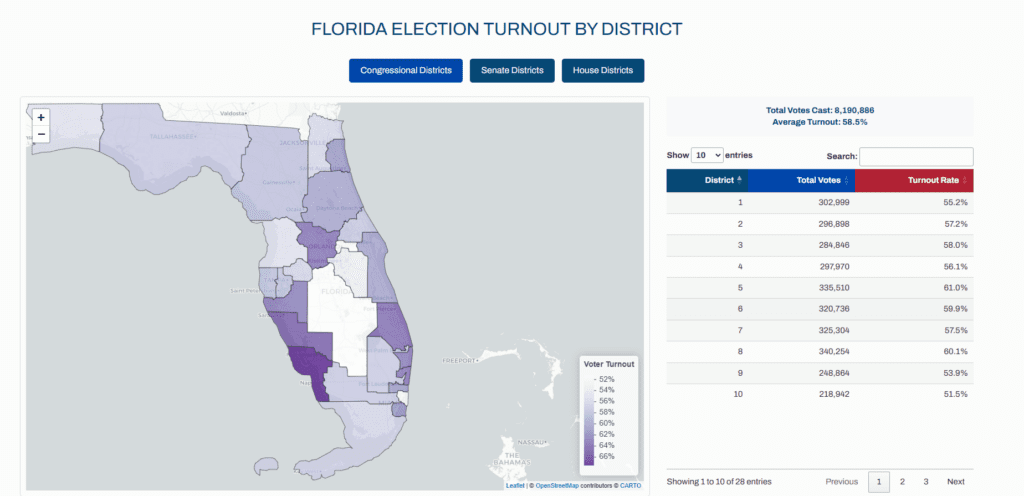Election Day is a whirlwind. Votes are cast, ballots are counted, and every minute adds new urgency as we wait for the results that will shape the future of our communities.
At The Tributary, we’re committed to making sure you have a clear, accurate picture of what’s happening in real time. That’s why we built two tools to scrape live voter turnout data throughout Election Day—tools that will let us know how many ballots remain as votes begin to be counted in each county and each Congressional, Senate and House district.
Our turnout scraper works by continuously pulling live data from all 67 county election supervisors across Florida. Every five to 10 minutes, we gather information on ballots cast at polling places, absentee ballots received, and early votes logged. By the end of Election Day, we have a comprehensive dataset that shows us how many ballots have been cast in each precinct—a crucial insight before the official results even start rolling in.
One tool that we first launched in August gives live updates for turnout for every county in the state. Our newest tool breaks the turnout down to the district level.
Florida 2024 Election Turnout by District

Why does this matter?
In Florida, early and mail ballots make up the vast majority of votes cast. Already, as of Monday morning, nearly 60% of registered voters have cast a ballot, and Election Day hasn’t even begun. Those early ballots are also the first votes reported by election officials.
How soon will we be able to call races?
Since early and mail ballots are counted quickly in Florida, we often call many district races within the first hour of results posting. Most of Florida is on Eastern Time, with nine counties on Central Time. The counties on Eastern Time will start posting results soon after polls close at 7 p.m. Eastern, while Central Time counties will follow an hour later.
What do voters need to know about how results are reported?
The first ballots to be counted—typically in-person early votes and mail votes—have trended more Democratic in recent years, reflecting voting preferences that often vary by party. Meanwhile, Election Day ballots have tended to favor Republicans.
In some states, like Pennsylvania, Election Day ballots are usually counted first, and unlike in Florida, Pennsylvania and some other states are prohibited by state law from pre-processing ballots. That pre-processing is what makes Florida so fast at reporting results, and the lack of it is what makes some states so slow.
As a result, initial results may favor one party heavily, only to change as different types of ballots are processed.
It’s not unusual or suspicious if early votes heavily favor one party while late votes favor the other. This is simply a reflection of different voting preferences across parties, and understanding this helps prevent misconceptions about the results.
How does The Tributary call races?
Responsible reporting, and calling races, doesn’t just mean tallying the numbers that have already been counted—it means comparing those numbers to the total ballots cast.
By comparing the live turnout data we’re scraping to the incoming results, we can tell when precincts and counties have reported nearly all of their ballots.
In the past, we’ve been able to call races when only a handful of precincts have fully reported. That’s because the early and mail ballots that were counted made up such a vast majority of the electorate that it was mathematically impossible for a given candidate to lose, even if they lost every Election Day ballot.
For our readers, this means you can trust that the calls we make on Election Night come from data-backed insights. When we announce a projected winner, it’s because our turnout data shows that the remaining ballots cannot change the outcome. It’s our way of ensuring we get it right—not just get it first.
The Tributary also provides live turnout maps by Congressional, Senate, and House districts throughout Election Day, available on our website. You can track which districts are seeing heavy turnout and which are falling behind. This data isn’t just informative—it’s empowering. Voters, candidates, and advocates alike can use it to mobilize last-minute efforts in areas with low participation, ensuring that as many voices as possible are heard.
We believe that elections are about more than just numbers—they’re about trust. By using technology to track every vote cast throughout the day, we hope to make the electoral process more transparent, more accountable, and more trustworthy. And most importantly, we want you to have the best data when it matters most.
We invite you to follow along with us this Election Day and explore the live turnout data yourself.
Starting at 7 p.m. tomorrow night, join our live stream on our homepage to see live election results as we try to make sense of what’s happening in our state and nation.
This article first appeared on The Tributary and is republished here under a Creative Commons license.









